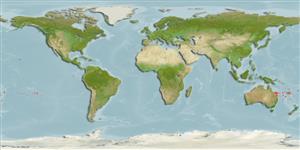>
Blenniiformes (Blennies) >
Blenniidae (Combtooth blennies) > Salariinae
Etymology: Cirripectes: Latin, cirrus = curl fringe + Greek, pektos, -e, -on = made of several parts solidly united (Ref. 45335); alboapicalis: Specific epithet 'albus' meaning white, 'apicalis' meaning apex, referring to the pale area at the tip of the dorsal-fin spines.
More on author: Ogilby.
Environment: milieu / climate zone / depth range / distribution range
Sinh thái học
Biển Cùng sống ở rạn san hô; Mức độ sâu 0 - 10 m (Ref. 529). Tropical; 20°S - 34°S, 148°E - 108°W
Pacific Ocean: Capricorn Group of the Great Barrier Reef, Lord Howe, Norfolk, Kermadec, Cook, Austral and Easter islands; also from the Pitcairn Group.
Length at first maturity / Bộ gần gũi / Khối lượng (Trọng lượng) / Age
Maturity: Lm ?, range 5 - ? cm
Max length : 15.5 cm NG con đực/không giới tính; (Ref. 89467)
Các tia vây lưng cứng (tổng cộng) : 12; Các vây lưng mềm (tổng cộng) : 15 - 17; Tia cứng vây hậu môn: 2; Tia mềm vây hậu môn: 16 - 18; Động vật có xương sống: 31 - 32. Diagnosis: Dorsal fin XII, 15-17 (usually 16), deeply incised above the last spine; anal fin II, 16-18 (usually 17); pectoral rays 14-16 (in general for the genus); pelvic fin I, 4; caudal fin procurrent rays 10-14. Gill rakers 25-31. Vertebrae 10 + 21-23 (usually 22); last pleural rib on 12th, last epipleural rib on 18th-23rd vertebral centrum. Body scaleless. Lateral line, anterior portion with small scalelike flaps, LL tubes 11-17 (rarely 9-10), series ends below and posterior to dorsal fin ray 12. Narrow inner ring of iris yellow, remainder black. Lower lip crenulated mesially, plicate laterally. Upper lip crenulae 34-52. Cirri, nuchal 28-42, supraorbital 4-18, nasal 8-27. Nuchal cirri in 2 groups, not overlapping at midpoint of nape, no nuchal flaps. First and second dorsal fin spine almost same height. Species name (albus - white; apicalis - apex) refers to pale tips of dorsal-fin spines. Adult brown in body color with spots; brown pupil-sized spot behind each eye. Ophioblennius stage overall light brown; lower lip both corners with dark spot; cirri brown; fins pale (in alcohol); dentary with 2-4 canines posteriorly (Ref. 529).
Facultative air-breathing in the genus (Ref. 126274); Found in coral reefs and rocky reefs (Ref. 529). Oviparous. Eggs are demersal and adhesive (Ref. 205), and are attached to the substrate via a filamentous, adhesive pad or pedestal (Ref. 94114). Larvae are planktonic, often found in shallow, coastal waters (Ref. 94114).
Oviparous, distinct pairing (Ref. 205). Urogenital orifice of male genital papilla located at distal tip or on posterior side of a single slender filament on a fleshy swelling behind anus; elongated testes, length equal to 2-3 times the width (Ref. 529).
Williams, J.T., 1988. Revision and phylogenetic relationships of the blenniid fish genus Cirripectes. Indo-Pac. Fish. (17):78 p. (Ref. 529)
IUCN Red List Status (Ref. 130435: Version 2024-1)
Threat to humans
Harmless
Human uses
Các nghề cá: không ích lợi (thú vị); Bể nuôi cá: Tính thương mại
Các công cụ
Special reports
Download XML
Các nguồn internet
Estimates based on models
Preferred temperature (Ref.
123201): 21.4 - 25.7, mean 24.8 °C (based on 183 cells).
Phylogenetic diversity index (Ref.
82804): PD
50 = 0.5000 [Uniqueness, from 0.5 = low to 2.0 = high].
Bayesian length-weight: a=0.00776 (0.00356 - 0.01695), b=3.00 (2.81 - 3.19), in cm total length, based on LWR estimates for this (Sub)family-body shape (Ref.
93245).
Mức dinh dưỡng (Ref.
69278): 2.0 ±0.00 se; based on food items.
Thích nghi nhanh (Ref.
120179): Chiêù cao, thời gian nhân đôi của chủng quần tối thiểu là dưới 15 tháng (Preliminary K or Fecundity.).
Fishing Vulnerability (Ref.
59153): Low vulnerability (10 of 100).
Nutrients (Ref.
124155): Calcium = 126 [64, 217] mg/100g; Iron = 0.8 [0.5, 1.4] mg/100g; Protein = 18 [17, 19] %; Omega3 = 0.0743 [, ] g/100g; Selenium = 24.7 [12.1, 55.5] μg/100g; VitaminA = 84.2 [20.8, 334.9] μg/100g; Zinc = 2.31 [1.53, 3.34] mg/100g (wet weight);
